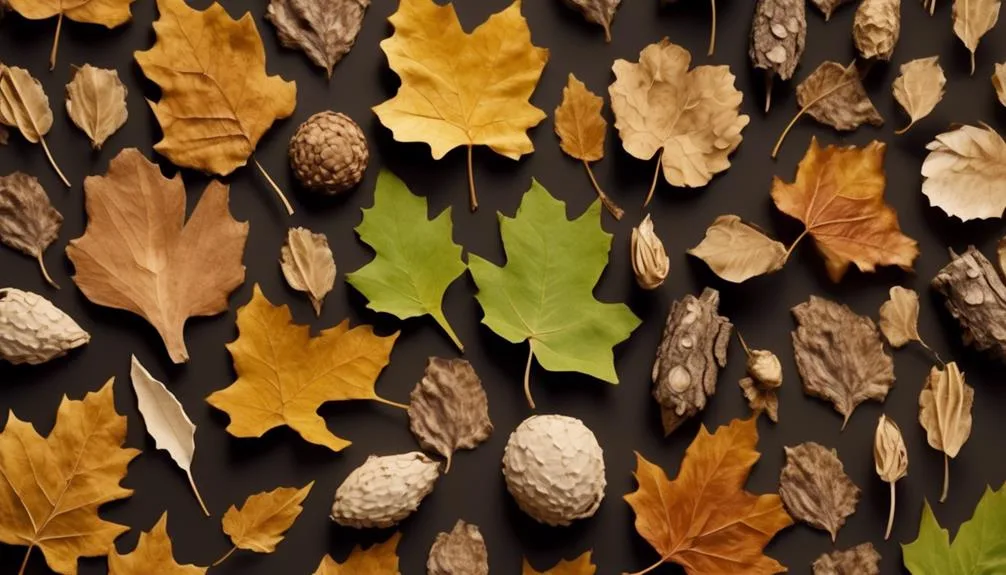Are you curious about identifying different sycamore tree species? Whether it's a London plane sycamore or an American sycamore, recognizing the differences can be quite intriguing.
By observing their bark patterns and leaf shapes, you can start appreciating the diversity within the sycamore family. But how do you tell them apart?
Let's explore the key features that distinguish these tree species.
Leaf Characteristics
When identifying sycamore tree species, examine the leaf characteristics to distinguish between varieties. Tree identification often begins with observing the leaf shape. Sycamore leaves typically have a broad, palmate shape with three to five deep lobes, resembling the shape of a hand. The edges of the leaves are often toothed or serrated, adding to their distinctive appearance.
Additionally, the size of the leaves can vary between different sycamore species, with some featuring larger leaves than others. Pay attention to the overall structure of the leaf, including the arrangement of veins and the presence of any distinctive markings.
Bark Features
To identify sycamore tree species, examine the distinctive bark features, such as its mottled pattern and peeling texture, which can vary among different varieties. When evaluating the bark of a sycamore tree, look for the following characteristics:
- Bark Texture: Check if the bark is smooth, rough, or flaky, as this can help distinguish between different sycamore species.
- Color Variations: Note any color differences, as the bark can range from white to gray, with hints of green or brown.
- Peeling Texture: Observe if the bark peels in large plates or small, thin flakes, as this can be a key identifier for specific sycamore varieties.
- Mottled Pattern: Look for a patchy or marbled appearance on the bark, as this is a common feature among sycamore trees.
Careful examination of these bark features will aid in accurately identifying different sycamore tree species.
Fruit and Seed Identification
Looking for distinguishing characteristics in the fruits and seeds of sycamore trees can aid in their accurate identification. Sycamore trees produce round, spiky fruits that hang in clusters and are about 1 inch in diameter. The texture of the fruit can vary from smooth to slightly bumpy, and the color may range from light green to brown.
When it comes to the seeds, they're small and brown with a tuft of hairs that helps them disperse in the wind. The shape of the seeds is typically round or oval. However, there can be variations in color and shape, so it's essential to observe these characteristics closely for accurate identification.
Paying attention to fruit size, texture differences, seed shape, and color variations can provide valuable clues for distinguishing between different sycamore tree species.
Geographic Distribution
After examining the distinguishing characteristics of sycamore tree fruits and seeds, it's time to explore their geographic distribution to gain a comprehensive understanding of these tree species.
When it comes to the geographic distribution of sycamore tree species, there are several critical factors to consider:
- Climate Preferences: Sycamore trees are known for their adaptability to various climates. They thrive in temperate regions and are commonly found in both humid and arid environments.
- Soil Requirements: These trees have a preference for well-drained, fertile soil. They can tolerate a wide range of soil pH levels, but they generally prefer slightly acidic to neutral soil.
Understanding the geographic distribution and the specific climate and soil conditions preferred by sycamore trees is crucial for successfully identifying and cultivating these magnificent tree species.
Growth Habit and Form
Sycamore trees exhibit a distinctive growth habit and form that sets them apart from other tree species in their natural habitat. They're known for their massive size, with some reaching heights of over 100 feet and having broad, spreading crowns.
The branches of sycamore trees are strong and tend to grow at right angles, creating a sturdy, symmetrical structure. When it comes to pruning techniques, it's essential to remove dead or damaged branches to maintain the tree's health and appearance. Additionally, proper pruning can help control the tree's size and shape.
Sycamore trees also have a significant environmental impact, providing shade, improving air quality, and supporting wildlife. Their large, dense foliage makes them effective at reducing noise pollution and mitigating the urban heat island effect.
Conclusion
In your future encounters with sycamore trees, remember to observe their leaves, bark, seeds, geographic location, and growth patterns for species identification.
By honing in on these distinguishing features, you can gain a deeper appreciation for the diverse sycamore tree species.
Happy tree identifying!

My interest in trees started when I first saw the giant sequoias in Yosemite.
I was a teenager then, and I remember thinking, “I need to learn more about this.”
That moment stuck with me.
A few years later, I went on to study forestry at Michigan Tech.
Since graduating, I’ve worked in a mix of hands-on tree care and community education.
I’ve spent over ten years helping people understand how to plant, maintain, and protect the trees in their neighborhoods.
I don’t see trees as just part of the landscape.
They are living things that make a real difference in our daily lives.
